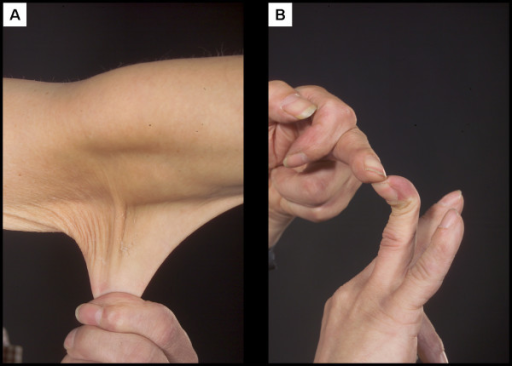Ehlers-Danlos syndrome (EDS) is a heterogeneous group of inherited connective tissue Connective tissue Connective tissues originate from embryonic mesenchyme and are present throughout the body except inside the brain and spinal cord. The main function of connective tissues is to provide structural support to organs. Connective tissues consist of cells and an extracellular matrix. Connective Tissue: Histology disorders that are characterized by hyperextensible skin Skin The skin, also referred to as the integumentary system, is the largest organ of the body. The skin is primarily composed of the epidermis (outer layer) and dermis (deep layer). The epidermis is primarily composed of keratinocytes that undergo rapid turnover, while the dermis contains dense layers of connective tissue. Skin: Structure and Functions, hypermobile joints, and fragility of the skin Skin The skin, also referred to as the integumentary system, is the largest organ of the body. The skin is primarily composed of the epidermis (outer layer) and dermis (deep layer). The epidermis is primarily composed of keratinocytes that undergo rapid turnover, while the dermis contains dense layers of connective tissue. Skin: Structure and Functions and connective tissue Connective tissue Connective tissues originate from embryonic mesenchyme and are present throughout the body except inside the brain and spinal cord. The main function of connective tissues is to provide structural support to organs. Connective tissues consist of cells and an extracellular matrix. Connective Tissue: Histology. The syndrome is due to genetic defects that affect collagen Collagen A polypeptide substance comprising about one third of the total protein in mammalian organisms. It is the main constituent of skin; connective tissue; and the organic substance of bones (bone and bones) and teeth (tooth). Connective Tissue: Histology processing and synthesis Synthesis Polymerase Chain Reaction (PCR). There are many subtypes that vary in terms of inheritance, severity, and clinical presentation. The diagnosis is mainly clinical but is confirmed via genetic testing Genetic Testing Detection of a mutation; genotype; karyotype; or specific alleles associated with genetic traits, heritable diseases, or predisposition to a disease, or that may lead to the disease in descendants. It includes prenatal genetic testing. Myotonic Dystrophies. There is no curative treatment. Management involves understanding the many complications of the disease and the interdisciplinary prevention and treatment of specific symptoms.
Last updated: Feb 8, 2025
Ehlers-Danlos syndrome (EDS) is a group of 13 inherited connective tissue Connective tissue Connective tissues originate from embryonic mesenchyme and are present throughout the body except inside the brain and spinal cord. The main function of connective tissues is to provide structural support to organs. Connective tissues consist of cells and an extracellular matrix. Connective Tissue: Histology disorders of collagen Collagen A polypeptide substance comprising about one third of the total protein in mammalian organisms. It is the main constituent of skin; connective tissue; and the organic substance of bones (bone and bones) and teeth (tooth). Connective Tissue: Histology processing or synthesis Synthesis Polymerase Chain Reaction (PCR). The syndrome is clinically heterogeneous and can affect the skin Skin The skin, also referred to as the integumentary system, is the largest organ of the body. The skin is primarily composed of the epidermis (outer layer) and dermis (deep layer). The epidermis is primarily composed of keratinocytes that undergo rapid turnover, while the dermis contains dense layers of connective tissue. Skin: Structure and Functions, joints, blood vessels, and other tissues and is characterized by the following:
This list of classifications is not exhaustive; it includes the most common, clinically significant subtypes.
Skin Skin The skin, also referred to as the integumentary system, is the largest organ of the body. The skin is primarily composed of the epidermis (outer layer) and dermis (deep layer). The epidermis is primarily composed of keratinocytes that undergo rapid turnover, while the dermis contains dense layers of connective tissue. Skin: Structure and Functions:
Musculoskeletal:
Cardiovascular:
Pulmonary:
GI:
Ophthalmic:
Obstetric/gynecologic:
Miscellaneous:

Examples of a patient with Ehlers-Danlos syndrome
A: Prominent hyperextensible skin
B: Hypermobile joints

Young girl with Ehlers-Danlos syndrome:
Joint laxity of the cervical spine is notable.

Young girl with Ehlers-Danlos syndrome:
Joint laxity of the fingers is notable.
Ehlers-Danlos syndrome is generally diagnosed on the basis of patient history and clinical findings.